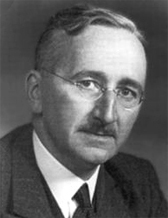In 1974, a renowned economist and Nobel Prize winner Friedrich A. von Hayek in his speech “The Pretense of Knowledge” criticized the economic policy of that time: “We [economists] have indeed at the moment little cause for pride: as a profession we have made a mess of things”.
Economic growth of the European Union Member States in 2012 was negative; unemployment is now a double digit. Therefore, it is worthwhile remembering the insights of Hayek. And not only because of the fact that current EU economic policy is subject to criticism. The analysis of economic booms and downturns made by Hayek, for which he received his Noble Prize, perfectly explains the reasons for today’s economic downturn and offers a way out.
The causes of business cycles lie in monetary policy. Central banks manipulate interest rates and together with the commercial banks increase the supply of money on the market (through the fractional reserve system) and, consequently, create artificial and unstable economic bubbles. The result of the latter is an inevitable and necessary downturn.
Interest rate has an important role in the market; it distributes income, i.e. scarce resources, between saving (necessary to investment) and consumption. It is important to understand that investment and consumption are an alternative use of resources, because investment is nothing more than a postponed consumption. Just like any other price, the interest rate in the market is formed by supply and demand. However, today in the monetary system, interest rate is set by central banks, so the interest is a carefully controlled price of money. This price is no longer a consequence of human choice between saving and consumption.
During the whole time of ECB activities since 1998, when ECB was established, we can distinguish two periods when ECB decreased interest rates severely in order to stimulate economy. The first period was around 2001-2005, when the main refinancing rate was cut from 4.5% to 2% and was kept for two and a half years. The second period started in 2008 and has lasted until now, with the interest rate cut from 3.75% to all time low 0.75%. The interest rate decreased respectively for companies and households in this period as well.
Decreasing interest rate and increasing supply of money creates short-term economic improvement; this is the main reason why ECB cut the interest rates during the economic downturn. The lower the interest rates are, the more investment projects are being started. In addition, people are encouraged to consume more and save less (because the reward for saving is smaller). Thus, economic improvement is brought on by increased consumption and investment levels.
„Cheap“ money can only be kept by central banks by constantly increasing supply. Throughout euro’s entire lifetime the most liquid money supply (M1, i.e. cash and overnight deposits) was increasing constantly – from 1999 to 2012 it increased more than 3 times (M3, which takes into account longer period deposits and other money as well, increased 2 times). The supply of money grew at a faster pace than economic productivity or GDP and this is the main reason for the continuously growing prices. Yet, price inflation is only one, and probably not the most important negative consequence of cheap money monetary policy.
The most important insight of the Hayek’s Business Cycle Theory: even though artificial economic growth created by monetary policy can last for a long time, it eventually ends up in recession. “Cheap” money distorts production structure and encourages to start new investment projects, which under market interest rates (not under rates which are currently being set by central banks) would simply be unprofitable (e.g. large real estate projects). Moreover, because of cheap money, capital is directed to sectors where capital is used not in the most productive manner.
At the same time, consumption level of households is increasing. Increasing demand for scarce resources (which are necessary for new investment projects and for increased consumption) increases the price – this is an important and clearly noticeable trait of artificial economic growth. Increased prices eventually force economy to “sober up” and to understand that in the boom period the consumption level and investment level is due to “cheap” money illusion. Then a recession – a painful, but necessary period – starts, consumption decreases, capital and labor reshuffle towards being more productive. High unemployment finally begins to decrease.
Hayek proposes a simple solution to set us free from economic downturn – do not use the same recipes which caused the downturn. ECB through its monetary policy of “cheap” money (which occurs not only by keeping low interest rates, increasing monetary base, but by creating new monetary policy instruments, by making it easier for commercial banks to borrow from ECB as well) artificially supports unproductive investment and unsustainable consumption level. This only prolongs economic hardship; economy is not allowed to reorganize and slowly a new economic boom wave begins.
„Overheating of an economy“ or “hard/soft landing” are commonly used terms. Unfortunately, they are too rarely associated with activities of central banks and contemporary monetary system – for an average economist, the activities of central banks and “cheap” money monetary policy seem inevitable. And this clearly shows that thinking and convictions about certain rarely questioned economic theories and fields of practice have to be reconsidered and changed from the core.



















2 Comments
My short article on monetary policy and business cycles!